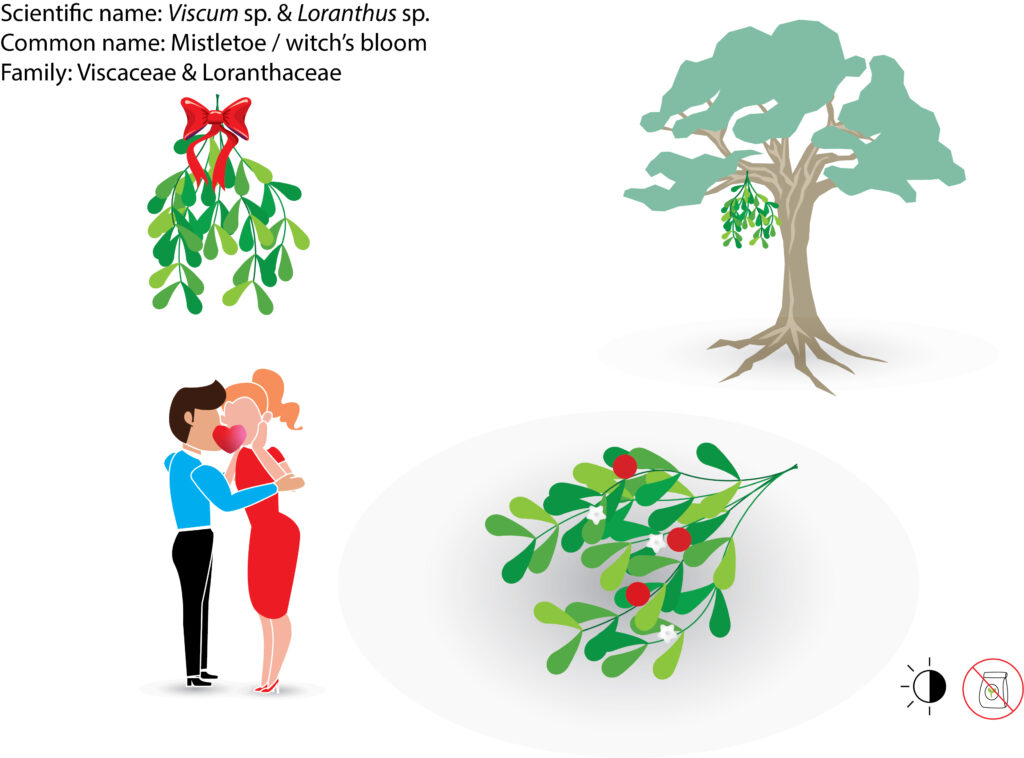Mistletoes are a diverse group of aerial parasitic plants, particularly obligate hemiparasitic with a worldwide distribution. It is usually found in the temperature forest along the Pacific rim of southern South America. It is a successful and interesting plant that parasitize trees and shrubs, establishing xylem connections with their hosts to obtain water and other xylem-borne nutrients. Mistletoe grows on a range of trees including willow, apple, and oak trees. It is also found on other woody trees. Mistletoe is the plant that occupies a habitat on a tree with a distinct spatial structure. This group contains five family members within Santalales. Two of the constituent families like Misodendronaceae and Eremolepidaceae are poorly known. The aerial parasitic genera are observed within the paraphyletic Santalaceae known from tropical forests in Latin America and Southeast Asia. This parasitic plant is also found under two major families, mainly Viscaceae and Loranthaceae. Both together consist of 72 genera and 1300 species of mistletoes, widely distributed throughout Europe, Americas, Africa, Asia, and Australasia (except Tasmania).
There are several popularly known mistletoes, which are Tristerix sp. (the most primitive genera), Arceuthobium sp., Loranthus europaeus, Viscum sp., and Phygilanthus sonorae. The common name mistletoe comes from two Anglo-Saxon words in which ‘mistle’ means dung and ‘tan’ means twig or stick, which means it is a ‘poo on a stick’! Although it has a less romantic meaning of the name, it is often being decorated during Christmas and as a symbol for intimate relationships and friendships. Mistletoe is a flowering plant that typically forms dense clumps in the crowns of their hosts. The clump of mistletoe is generally composed of semi-succulent mistletoe stems and leaves. Mistletoes are also referred to as witch’s broom due to their morphology as a clump like a broom. The flowers are pollinated by insect and bird species to form fruits containing seeds.
Most species of mistletoes are propagated and dispersed with the help of birds. There are several dispersal mechanisms by different birds. Birds like mockingbirds (Mimus polyglottis) and gray thrashers (Toxostoma cinereum) swallow the fruits but regurgitate the seeds. However, the fruits of the mistletoes are eaten as natural laxatives by birds like phainopeplas (Phainopepla nitens), Ash-throated flycatchers (Myiarchus cinerascens), and cedar waxwings (Bombycilla cedrorum). The seeds are then defaecated or otherwise voided, which may stick to and establish on host trees’ branches. Generally, the larger the tree, the better perches, or larger targets for ejected seeds, receive more seeds, and therefore more likely to be infected.
Mistletoe is an important food source as the berry contains nectar, essential minerals, and nutrients for birds and mammals. The branch and leaves are always formed in dense clumps, birds like to use them as a nesting site. The tradition of hanging it in the house during Christmas goes back to the ancient Druids’ times. It is believed to possess mystical powers that bring good luck to the household and ward off evil spirits. It is also symbolized as love and friendship in Norse mythology. The early Christian church in Britain made great efforts to ban the use of mistletoe because of its strong associations with the powerful Druids. However, the tradition continues. York Minister Church in the United Kingdom used to hold a special mistletoe service in the winter where wrongdoers could come and be pardoned. Mistletoe is associated with fertility and vitality. The berries are sticky and likely to appear in pairs or in close bonded groups. People believe a kiss on all those who passed beneath would have the relationship being blessed and last forever. The earliest recorded date mentioning kissing under the mistletoe is in the year 1784 in a musical event. Although originated from England, but is popular around the world. It’s the sense of ritual that the sprig of mistletoe with berries hanging on the pairs who are kissing each other, and when all the berries are gone, there should be no more kissing!

Further readings:
Amico, G. & Aizen, M. A. (2000). Mistletoe seed dispersal by a marsupial. Macmillan Magazine Ltd.
Watson, D. M. (2001). Mistletoe- A keystone Resource in Forest and Woodlands Worldwide. Annual review of exological system, 32, 219-249.
Overton, J. M. (2020). Dispersal and Infection in Mistletoe Metapopulations. Journal of Ecology, 82(4), 711-723.